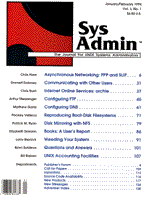
Sidebar: What's Out There?
The following list gives you a small taste of the kinds of services available to Internet users. Each service occupies its own little niche in the vast web of information that is the Internet. Finger A utility used to find information about the users of a particular computer. You can finger a user at a remote site using a command like:
finger [email protected]
If there is a user named ryan on some.computer, you might see this:
Login name: dryan In real life: Dan Ryan Directory: /usr/users/ryan Shell: /bin/csh Last login Fri Dec 24 23:57 on console Unread mail since Sat Dec 18 21:12:03 1993 No Plan.
Whois Another utility used to find information about Internet users, usually those involved with the government, or network service providers. Perhaps the most frequently used service on the whole Internet. Whether it's with your brother-in-law at a university half-way across the country or another systems administrator on the other side of the globe, e-mail is a terrific way to exchange information. Mailing Lists Mail distribution lists that cater to various special interests. Mail sent to such a list is forwarded to each "subscriber," either a message at a time, or encapsulated in a digest form. Anonymous FTP Utility that makes files available to anyone on the Internet, without requiring a login and password on the computer acting as the anonymous ftp server. Users establish an ftp connection, log in as user anonymous, and, as a courtesy, send their e-mail address as a password. They then have the ability to get any file that has been made publicly available from that ftp server. USENET News Newsgroup, newsgroups, and more newsgroups-perhaps more aptly titled discussion groups. Usenet (often called net news) allows people to engage in on-line "conversations" with others having similar interests. Discussion groups cover a large number of topics grouped under general headings. Users "subscribe" to those groups of interest to them. Access to news is through the use of news reader software. Several news readers are available in the public domain. News groups of interest include comp.sys.sgi.admin and comp.sys.sun.admin for discussions related to administration of several popular UNIX systems. Archie A useful way to find software and other files available from anonymous ftp sites. Information provided includes the path to files and the name of the anonymous ftp server upon which they reside. Gopher A menu-driven distributed client/server information system. Gopher was developed at the University of Minnesota (The Gopher State), and is rapidly becoming one of the most widely used Internet resources. Using gopher, I can do everything from getting a local university library without having to know that the information I retrieved came from two different computers in different locations. To try a public access gopher: use telnet to connect to consultant.micro.umn.edu, and login with a user name of gopher. WAIS (Wide Area Information Server) A distributed client/server-based information system. WAIS servers contain indexes to the documents they make available. Using a WAIS client program, you can query those indexes until you find a reference to a desired topic. You can then use WAIS to look at each document. To get a sample of what you can do with WAIS, telnet to quake.think.com, login with user name WAIS. World Wide Web On the surface, World Wide Web (WWW) may appear much like gopher, and in fact you can access gopher servers equally well. The biggest distinction between the two is WWW's support of hypertext. Rather than being limited to the menu structure of gopher, you can follow hypertext links around the Web, searching for items of interest, and expanding upon topics as need arises. Its Hypertext capability and integration with other services (gopher and WAIS) make the World Wide Web a powerful tool for information search and retrieval on the Internet.
|